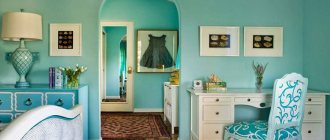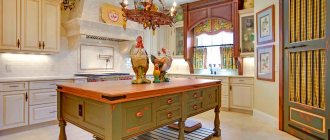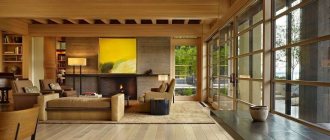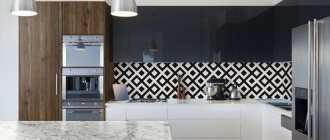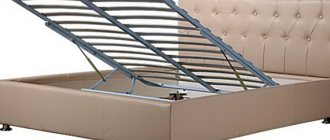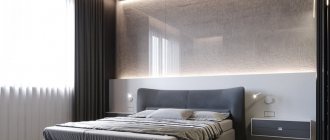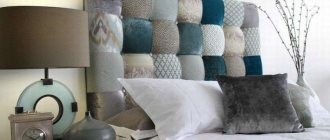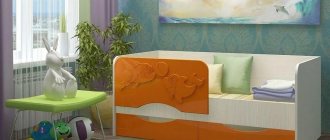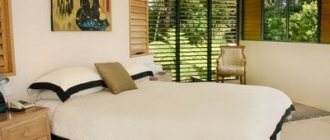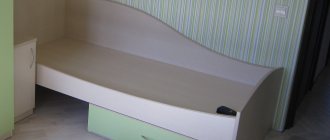A Japanese-style bed will appeal to all lovers of inspiration and aesthetics. Their main feature is exquisite minimalism combined with rigor and restrained color schemes. The furniture is miniature, which makes the style truly elegant and memorable. The Japanese are delighted with bamboo, wood and ceramics and embody grandiose ideas with the help of these materials. There is no artificiality here - only everything natural is used. Residents of the Land of the Rising Sun know a lot about interiors.
From this article you will learn about the features and will undoubtedly think about buying a Japanese-style bed and how to properly decorate a bedroom in this direction. A Japanese-style bedroom will provide you with a sound and healthy sleep. Most importantly, do not forget about the main principles: minimalism, authenticity, modesty and tradition.
What does a Japanese bed look like?
A traditional Japanese bed is made of natural wood.
The sleeping place is a wooden frame with two load-bearing beams and parallel slats placed on them. Usually such a bed has four legs in the corners, but if the bed is too wide, then be sure to install a fifth one in the center.
The legs of a Japanese bed are usually thick and are not located directly at the corners, but at some distance towards the middle. This creates the feeling that the bed is floating above the floor surface.
The space under the bed can be used to store bedding or other items. There are also types of sleeping places, the design of which does not include legs.
This type is not entirely acceptable for European people, in particular due to hygienic reasons. People suffering from dust allergies are better off buying Japanese beds with legs or choosing high mattresses. The sleep&fly mattress is perfect for such beds.
A traditional Japanese bed usually has a headboard . It should be simple and strict in color scheme. In general, when decorating a room in Japanese style, the color scheme consists of no more than three primary colors. The room is also characterized by a small amount of miniature furniture. This type of room design is ideal for a comfortable stay.
It is generally accepted that a real high-quality bed from Japan can only be purchased in this country. This is quite expensive, and the usual mattress of a bed delivered from Japan is replaced by a hard futon. It is better to immediately replace it with an orthopedic mattress. Visit the website https://101matras.com.ua/
This bed is made of Scandinavian pine, which retains all the authenticity of the Japanese style, it is ideal for rooms with a low or attic ceiling, designed for lovers of a low tatami bed. The bed can be combined with two types of bedside tables: tatami and solid wood
Coloring and design
Japanese style is characterized by simplicity and minimalism. This leaves an imprint on the design of bedroom furniture. The design of the bed does not allow for flashy voluminous decor. Asceticism is emphasized in everything: frame, mattress, bed linen. The palette is limited to calm, muted tones. To ensure that the appearance of the furniture remains harmonious, no more than three shades are used simultaneously for decoration. Natural wood, leather and textiles allow you to fulfill this rule. Most often the color scheme includes:
- beige;
- brown;
- grey;
- black;
- white;
- salad.
Stylish models of Italian modern beds, the best manufacturers
To maintain the Asian style, the bed must fit organically into the interior of the bedroom. To do this, create an appropriate environment in the room. Design support is provided by paintings, photographs, vases, mats, panels, figurines, and lamps. All decorative elements should also be in the spirit of the East.
The visual perception of the bedroom is influenced by textile accessories. First of all, these are bed linen and bedspreads. According to the laws of oriental design, tatami are covered with several types of capes, which differ in shape, size, and texture. Their choice is very scrupulous. For sewing bedspreads and bed linen, only environmentally friendly natural fabrics are used - silk, cotton. The color should be monochromatic or with an inconspicuous small pattern.
Textiles should not have lush frills, ruffles, or bows.
How to make a Japanese bed with your own hands.
A Japanese style bed is my first attempt at making something with my own hands. And I'm very pleased with how it all turned out. If you have any questions along the way, don't hesitate to ask.
This instruction will be more of an inspiration than a step-by-step guide.
The trick of the bed design is that it is made without a single screw (in fact, I used 2 screws, but you can do without them).
It took me about 16 hours to create and only 70 euros.
Japanese bed
Materials and finishing
Interior design in oriental style involves the use of natural materials. Artificial analogues are also acceptable, since their performance properties are often better.
The walls of a laconic Japanese bedroom are covered with paint or wallpaper. To add texture, you can decorate the space with wood panels or decorative plaster. One of the popular and environmentally friendly solutions is natural bamboo sheets that are glued to the wall.
The photo shows an accent wall with a painting on an ethnic theme: cherry blossoms and ancient Japanese architecture.
Perhaps the most recognizable element of a Japanese bedroom is the sheathing. It is used in the decoration of ceilings and walls. In eastern interiors it is impossible to find a round or multi-tiered ceiling: it has a rectangular shape, sometimes complemented by beam structures or wooden cladding.
Since residents of the Land of the Rising Sun prefer to walk around the house barefoot, wood or its analogues - parquet or laminate - are used as flooring. Ceramic tiles are much cooler, so without a “warm floor” system they are not so popular.
Assembly of the structure
Before assembling the parts into a single whole, all components should be carefully processed. To do this, you can use a plane. With its help, all irregularities and burrs are effectively removed from the surface of the wood. In addition, this way the workpieces are adjusted to the required size if they do not correspond to the previously completed sketch.
Don't forget about supports. The preferred length of the legs is 30 cm, but you can choose any.
After this, the blanks are cut into parts. All you need is:
- support legs – 4 pieces;
- longitudinal frame guides;
- headboard;
- foot.
When marking, it should be taken into account that the width of the footboard should be approximately 8-10 cm larger than the dimensions of the headboard. This is due to the peculiarities of fastening this structure to the bed frame.
Next, the frame is assembled. The rear beam must be secured between two side rails. And the front part and the corresponding ends of the longitudinal guides are cut at an angle of 45 degrees and fastened together. To ensure that the parts are in close contact, use a square when marking.
The frame of a Japanese bed must have perfectly even corners. To make the structure rigid, you can use special furniture corners, but in most cases, supports that are fixed to the corners of the frame from the inside are sufficient.
The middle is marked on the purchased block, according to which you need to draw and select the groove required to accommodate the side guide. And the upper part of the block will play the role of a corner.
After cutting, all parts are processed again using a grinding machine and sandpaper. This will remove all burrs and prepare the wood for further coating with varnish, stain or paint.
To fasten all the parts together, use a regular screwdriver and self-tapping screws. Inside, longitudinal stiffening ribs are secured with bolts, onto which logs are laid that serve as support for the mattress. If the bed is double, then a beam or metal part is fixed in the middle, giving the structure additional rigidity.
Once the frame is ready, you can attach the footboard and headboard.
The last stage is painting the bed.
Key points for assembling the structure
Choosing floors
Most likely, you know that in Japan it is customary to take off your shoes when entering a house. It follows that the floor covering should be pleasant to bare feet.
The most natural material is real wood. Parquet or boards can be replaced with laminate, but in no case with linoleum; it is desirable that the board be clearly felt under your feet.
A clear example of color balance in the interior.
Maintain color balance. For example, if you want to make the floor dark, then the furniture and decorative elements should be the same.
Read also: Rules for designing an apron in a Provence style kitchen
LiveInternetLiveInternet
—Categories
- WITH YOUR OWN HANDS (821)
- Jewelry, accessories (144)
- Paintings, panels (102)
- Lamps, lamps, chandeliers (92)
- Candles, candlesticks (84)
- Dishes, vases, flower pots (72)
- Watches (55)
- Miscellaneous (37)
- Rugs, rugs (37)
- NEW YEAR (471)
- Christmas trees (23)
- DIY FURNITURE (411)
- HOROSCOPE (344)
- HOLIDAYS (306)
- LIFE HACKS, USEFUL TIPS (266)
- PAPER, CARDBOARD (266)
- Paper Christmas (68)
- Packaging (57)
- Miscellaneous (46)
- Postcards (35)
- Cardboard chests of drawers (29)
- Quilling (5)
- PSYCHOLOGY, SELF-KNOWLEDGE (215)
- SLAVS (135)
- EMBROIDERY (126)
- New Year embroidery (9)
- HOUSE, Cottage, VEGETABLE GARDEN (105)
- SIMORON, DREAMS, DESIRE (92)
- STONES (ZODIAC, TALISMANS) (66)
- DIY REPAIR (52)
- MUDRA (43)
- AROMATHERAPY (43)
- MEDITATIONS (38)
- HOUSE PLANTS (36)
- MISCELLANEOUS (34)
- AYURVEDA (27)
- Yoga (23)
- VIDEO (27)
- FABRIC DYING (26)
- DECOUPAGE (23)
- PLASTIC BOTTLE (18)
- NUMEROLOGY (12)
- DRAWING LESSONS (12)
- WIRE (12)
- STYLE (10)
- INTERIOR (10)
- FOAMIRAN, PORCELAIN, CLAY (9)
- INTERESTING (8)
- LIFE HACKS FOR PHOTOGRAPHERS (7)
- AFFIRMATIONS, MANTRAS (7)
- MACRAME, WEAVING (7)
- GIFTS (5)
- CONGRATULATIONS, POEMS, TOASTS (5)
- STAINED GLASS, MOSAIC (5)
- PAINTING (4)
- ART THERAPY, COLORING BOOKS (4)
- DREAM INTELLIGENCE (4)
- ISONIT (3)
- ANIMALS (3)
- DATES (2)
- FELTING (2)
- PAINTING (1)
- LEISURE (1)
- PHOTOSHOP (1)
- TRIP (1)
- POSITIVE, HUMOR (0)
- COOKING (1369)
- Salting, pickling, pickling (149)
- Jam, compotes (43)
- Sauces, ketchups, gravies (35)
- Fried baked goods (25)
- Snack (22)
- Salt, seasonings (11)
- Unbaked pastries (8)
- Dairy recipes (7)
- Creams, glazes, mastic (6)
- Porridge (5)
- Cheeses, sausages, pates (5)
- Cooking in a slow cooker (4)
- Dough (3)
- Products (2)
- Recipes for diabetics (1)
- First courses (34)
- Main courses (65)
- Salads (64)
- Baking (252)
- Desserts (143)
- Drinks (170)
- New Year's recipes (165)
- Various recipes (34)
- Useful tips (97)
- HEALTH (1067)
- Therapeutic massage, gymnastics (100)
- Runny nose, colds, flu (31)
- Stress, nerves (20)
- Insomnia (15)
- Teeth, gums, bad breath (5)
- Diet (5)
- Miscellaneous (1)
- Traditional recipes (16)
- Teas, drinks for weight loss (17)
- Women's health (12)
- VEGETARIAN CUISINE (406)
- Fried baked goods (8)
- Dough (3)
- Miscellaneous (1)
- First courses (79)
- Main courses (56)
- Salads (91)
- Sauces, mayonnaise (3)
- Baking (34)
- Desserts (36)
- Drinks (80)
- Multicooker (3)
- Snack (1)
- Useful tips (2)
- BEAUTY (745)
- Beauty calendar (54)
- Cosmetics (40)
- Body (23)
- Feet, pedicure (22)
- Miscellaneous (8)
- Tips (7)
- Neck (7)
- Bust (4)
- Face (155)
- Eyes, makeup (53)
- Hands, manicure (68)
- Hair (102)
- Bath bombs (28)
- Soap (72)
- RAW FOOD (2)
- SPORT (101)
- Stretching, warm-up (8)
- Breathing exercises (3)
- Articles (1)
- Fitness (8)
- KNITTING (6242)
- Summer pullovers, blouses (652)
- Tops, T-shirts (522)
- Men's pullovers, sweaters (426)
- Hats, berets, caps (351)
- Magazines (283)
- Two-pieces, suits, sets (279)
- Knitting for home (188)
- Men's jackets (156)
- Men's hats, scarves, snoods (147)
- Patterns, elastic bands (137)
- Vests, sleeveless vests (110)
- Magazines without translation (87)
- Men's vests, sleeveless vests (83)
- Knee socks, socks, shoes (79)
- Summer jackets, bolero (71)
- Miscellaneous (69)
- New Year's knitting (68)
- Polantines, scarves, shirtfronts (62)
- Bags, backpacks, cosmetic bags (62)
- Mittens, mittens, gloves (31)
- Shawls, scarves, bacti (26)
- Toys (25)
- Knitting for children (15)
- Men's socks, slippers (15)
- From yarn and thread (14)
- Pants, leggings, shorts (14)
- Accessories, decorations (11)
- Swimwear (10)
- Men's sets (7)
- Knitting without description (5)
- Plus sizes (4)
- Men's mittens, mittens (3)
- Knitting without translation (2)
- Chanel style jackets (2)
- Jackets, cardigans, coats (667)
- Pullovers, jumpers, sweaters (1400)
- Dresses, sundresses, tunics, skirts (448)
- CROCHET (702)
- Knitting for home (181)
- Bags, backpacks, cosmetic bags (62)
- New Year's knitting (56)
- Tops, T-shirts (53)
- Summer pullovers, blouses (51)
- Magazines (46)
- Dresses, tunics, skirts (38)
- Men's pullovers (33)
- Jackets, cardigans, coats (33)
- Caps, berets, hats (29)
- Pullovers, jumpers (28)
- Miscellaneous (20)
- Accessories, decorations (17)
- Sets, suits, two-pieces (15)
- Toys (14)
- Swimwear (10)
- Summer jackets, bolero (7)
- Vests, sleeveless vests (2)
- Men's vests (1)
- Patterns (1)
- Men's socks (1)
- SEWING (1036)
- Sewing for home (233)
- Patterns (221)
- Miscellaneous (185)
- Bags, cosmetic bags, wallets (140)
- Dresses, sundresses, tunics, skirts (71)
- New Year's sewing (46)
- Shirts, shirts, blouses (25)
- Clothes alterations (23)
- Coats, jackets, jackets, blazers (20)
- Toys (19)
- Accessories (13)
- Shoes (13)
- Pants, capris, shorts (8)
- Hats (8)
- Swimwear, underwear (4)
- T-shirts, tops, blouses (2)
- Hoodies, sweatshirts (2)
- Video sewing (2)
- MAGIC, SIGNS, DIVINATION (771)
- BEAD (284)
- Earrings (79)
- Bracelet (64)
- Necklace, necklace (34)
- Miscellaneous (26)
- New Year's (24)
- Sets (16)
- Pendants, pendants (13)
- Animals (9)
- Flowers (9)
- Ring, ring (5)
- Accessories (4)
- Brooch (2)
- QUOTES, APHORISMS, SMART THOUGHTS (7)
Historical facts
Traditional Japanese houses were built to suit the local climate, which was warm and humid. The basis of the dwelling was a light wooden frame, an earthen floor and a thatched roof. Instead of internal walls, sliding partitions (fusuma) were used.
The life of the Japanese of distant eras was a “floor” life. There were no chairs or beds in his house; everything was placed on rugs. During the daytime, the Japanese family gathered around a low table, at which meals and tea drinking took place. The decoration of the house was completely ascetic. The room was decorated with a stone lantern, which also served as a lamp.
Since ancient times, Japanese people have been accustomed to sleeping on the floor or on a straw mat. The pillow was a log or a wooden headrest in which a rotating cylinder was mounted. But the rich Japanese preferred tatami mats, although at that time they were harder and more uncomfortable than modern futons. The family covered themselves with one blanket.


